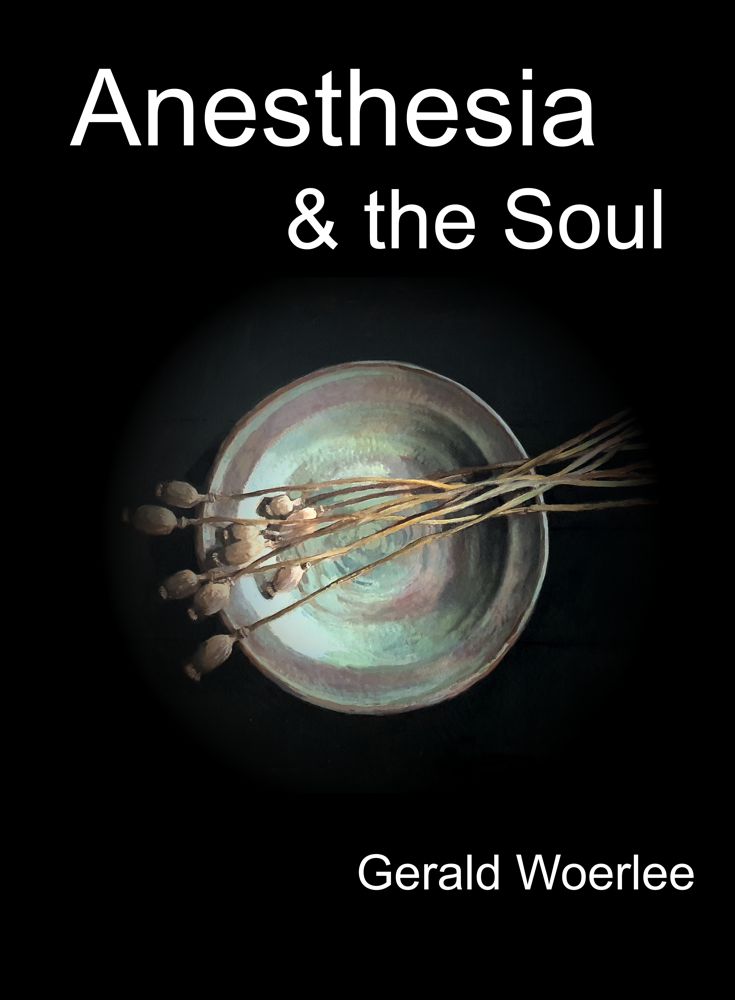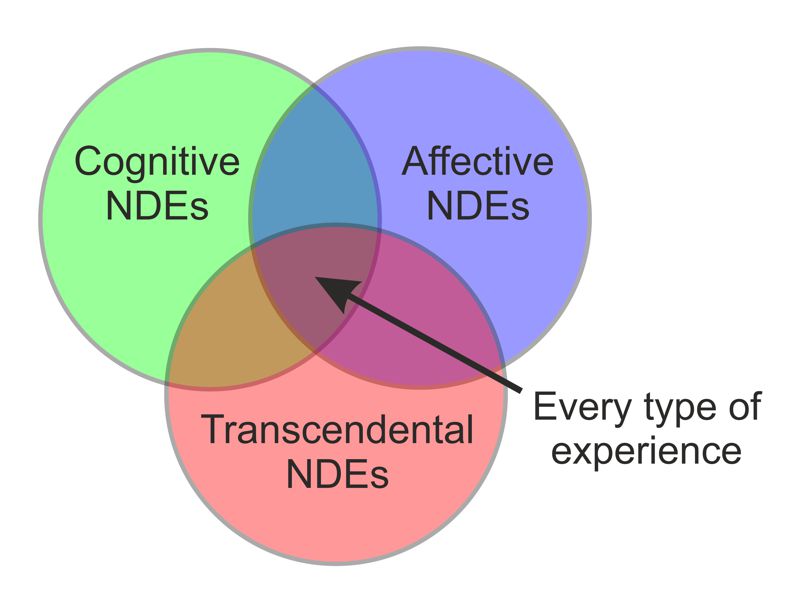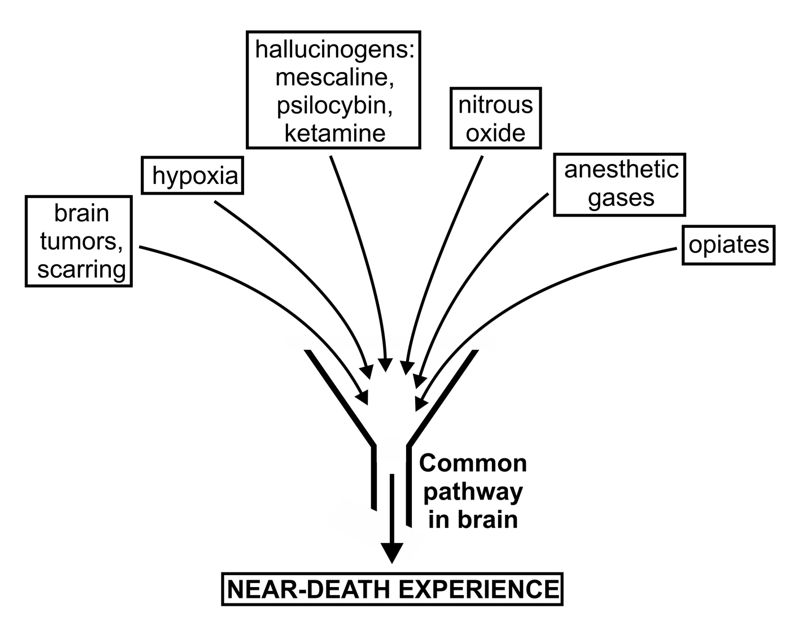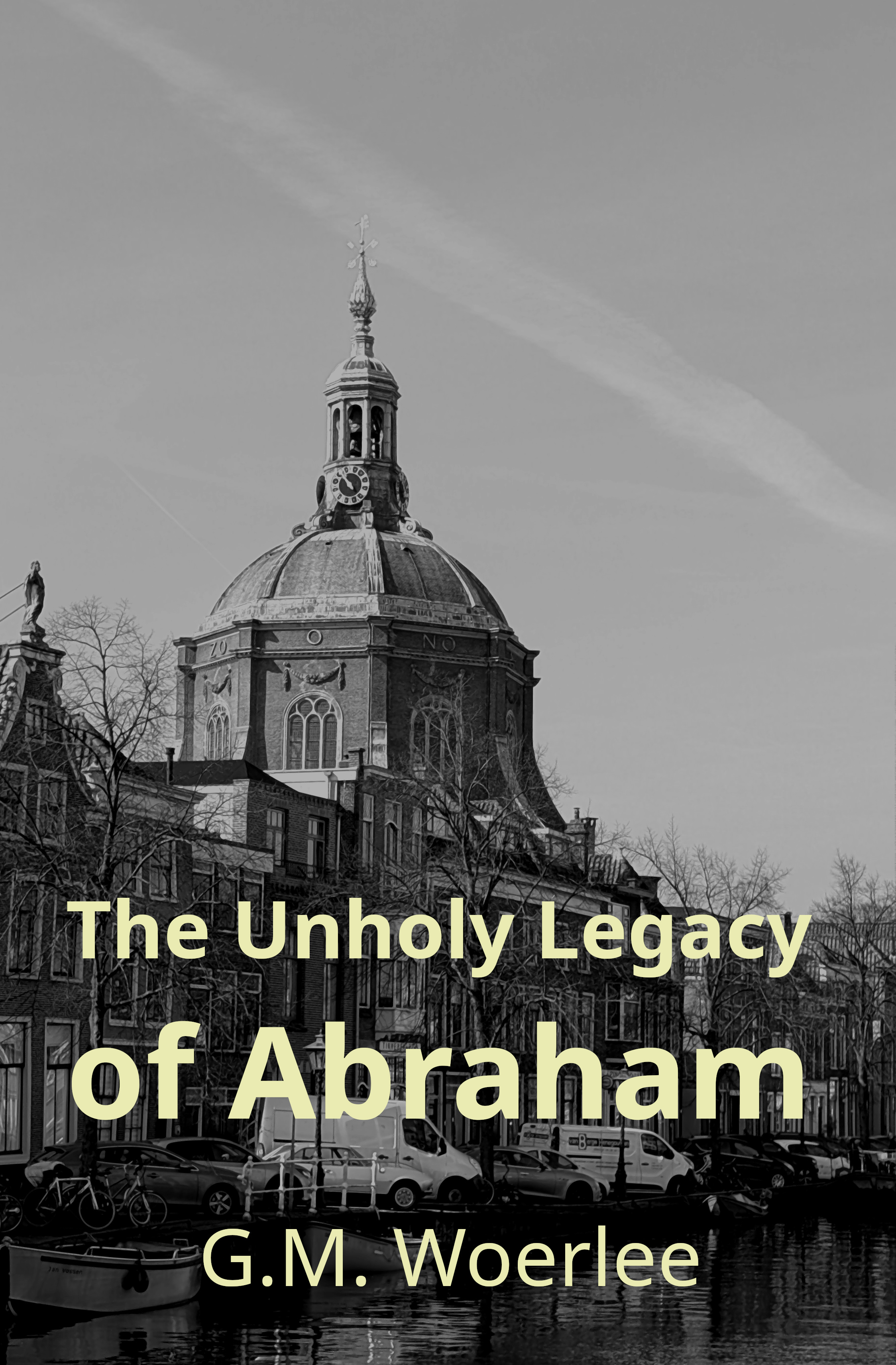NDE’s & Common Pathways in the Brain
 Near-death experiences (NDE) are one of the reasons why belief in the reality of a human soul, the reality of a life after death, and the reality of supernatural entities such as gods, angels, and demons have persisted throughout all known history. They are the ostensibly wondrous core of human experiences underpinning belief in a separable human soul, the fundaments of nearly all religions, and ostensible proof of the reality of the preachings of their prophets. After all, no belief survives thousands of years without repeated “proof”, and reports of “unexplained” wondrous experiences such as near-death experiences (NDE&rsqo;s) are ostenstibly just such “proof” (see the book: “The Unholy Legacy of Abraham”).
Near-death experiences (NDE) are one of the reasons why belief in the reality of a human soul, the reality of a life after death, and the reality of supernatural entities such as gods, angels, and demons have persisted throughout all known history. They are the ostensibly wondrous core of human experiences underpinning belief in a separable human soul, the fundaments of nearly all religions, and ostensible proof of the reality of the preachings of their prophets. After all, no belief survives thousands of years without repeated “proof”, and reports of “unexplained” wondrous experiences such as near-death experiences (NDE&rsqo;s) are ostenstibly just such “proof” (see the book: “The Unholy Legacy of Abraham”).
The NDE is a fascinating human experience, which aside from any possible confirmation of religious beliefs, also reveals much about the functioning of the human mind and body. For example, near-death experiences provide some basic clues and ideas about how the brain could generate these experiences. Such basic ideas of possible mechanisms are revealed by examining the archetypal NDE.
The archetypal NDE
Raymond Moody was the first to clearly classify and define the nature, and various features of of near-death experiences in a book published during 1976 called “Life after Life”. He defined ten components of the near-death experience, which he also described as occurring in the following sequence:
1 - A feeling of peace and calm.
2 - The sense that death was imminent or had occurred.
3 - Hearing a noise or music.
4 - The experience of entering a tunnel or darkness.
5 - The experience of leaving one’s body.
6 - Meeting figures, strangers, deities or deceased relatives.
7 - Meeting a being of light, or entering into a brightness or light.
8 - A review of the major events of one’s life.
9 - The experience of encountering a border, or limit, the passing of which means certain death.
10 - The conscious decision to return to the body.
Not all NDE’s are the same
Subsequent analysis revealed that not all those reporting near-death experiences actually undergoes each of these components. Pim van Lommel published an analysis of the relative frequencies of each of these components in 62 out of 344 prospectively studied cardiac arrest survivors reporting undergoing near-death experiences during resuscitation for cardiac arrest (Lommel 2001).
- 56% experienced a feeling of peace and calm.
- 50% experienced a sense that death was imminent or had occurred.
- 32% met figures, strangers, deities or deceased relatives.
- 31% felt themselves entering a tunnel or darkness.
- 24% underwent an out-of-body experience.
- 23% met a being of light, or entered into a brightness or light.
- 13% underwent a review of the major events of their life.
- 8% experienced encountering a border, or limit, the passing of which means certain death.
Groups of Experiences
This list clearly indicates that not everyone undergoes each component of the near-death experience. In other words, while there are many shared experiences, each person may undergo a unique combination of these experiences during an individual near-death experience. Another near-death experience researcher, Bruce Greyson, he published a study revealing four different clusters of experiences truly belonging to the near-death experience, and defined these groups of experiences as: affective, cognitive, transcendental, and paranormal (Greyson 1983, Greyson 1985). So how are these different types of experience defined?
- Cognitive experiences: time seems to speed up, thought is very clear and rapid, review of scenes from the past, understanding of the universe, oneself and others.
- Affective experiences: a feeling of relief, peace or pleasantness, a feeling of joy or happiness, a sense of harmony or unity with the universe, seeing, or being surrounded by bright light.
- Transcendental experiences: entering a mystical or unearthly world, encountering a mystical being or presence, seeing figures from a religious pantheon, seeing deceased relatives or friends, coming to a barrier, or point of no return.
- Paranormal experiences: senses are more vivid than usual, extrasensory perception, seeing scenes from the future, separation from the body.
Bruce Greyson found that paranormal experiences occurred with equal frequency during all types of near-death experience. Curiously, he found that the well-known experiences of altered time perception and of passing through a tunnel were unrelated to all other components of the near-death experience. He concluded that even though experiences of altered time perception, and passage through a tunnel, occurred frequently during near-death experiences, they were unrelated to other components, and therefore are not actual components of the near-death experience (Greyson 1983).

Each circle in this Venn diagram represents a constellation of experiences belonging to a group of experiences. Where two circles overlap, a person will report undergoing experiences belonging to these two groups of experiences during a near-death experience, while when all three circles overlap this represents persons reporting undergoing experiences in each of the three groups during a near-death experience. This also reveals that it is unusual for people to report undergoing the full gamut of experiences during a near-death experience.
So near-death experiences are not a unitary phenomenon — no two near-death experiences are identical. This concept of different types of experience is a potentially powerful instrument to investigate the near-death experience.
Even so, it is remarkable how a multitude of conditions, states of mind, and disorders can result in the relatively few manifestaions of the near death experience. For example, near-death experiences occur during the following diverse conditions.
- During conditions of extreme fear, or anxiety.
- During general anesthesia and other drug intoxications. For example during ketamine administration, local anesthetic toxicity, and general anesthesia.
- During cardiac arrest.
- During blood loss resulting from injuries or surgery.
- During high fevers.
- Hypoxia in its myriad forms is a common initiating cause.
- Brain tumors, or scars from brain operations.
- Many, many other conditions.
Yet even though these multitude of causes differ, they all generate similar groups of affective, cognitive, and transcendental experiences, as are reported by people recalling their near-death experiences. This repeated observation indicates that these multitudinous initiating causes all act, and exert their effects through the same bodily systems, or “common pathways”, to generate the constellation of experiences labeled as “near-death experiences”.
Common Pathways
So what do I mean by a “common pathway”, or multiple“common pathways”? Each of these causes, or triggers of near-death experiences, including psychological causes, produces its own constellation of effects upon the functioning of the brain. But some of the neural pathways of the brain through which these triggers act upon the functioning of the brain, are also those generating the constellation of experiences called the near-death experience. And these same pathways are activated by each of the triggers inducing near-death experiences. The fact of three clearly different types of experience — affective, cognitive, and transcendental, with an overarching covering of paranormal experiences — indicates the possibility of three different “common pathways” by which all these diverse, and apparently unrelated triggers act to generate the common features of near-death experiences.

Each of a multitude of causes of a near-death experience generates experiences through one or more common pathways. For example, the feeling of “peace and calm” described by so many during a near-death experience is the consciously experienced result of multiple stimuli finally culminating in the expression by pathways in the brain of the conscious experience of “peace and calm”. The same is applicable to each of the three main groups of near-death experiences, with three final common pathways: one for transcendental experiences, one for cognitive experiences, and one for affective experiences.
“Anesthesia & the Soul” reveals the soul possesses no memory, indicating that near-death experiences are actually products of abnormal brain function in physically conscious persons capable of remembering these experiences, and recalling them sometime later. Consider the fact that these mental states, and near-death experiences, also occur during altered states of conscious physical brain function, such as are induced by attempted suicide , fear of death, and meditation. Likewise, oxygen starvation, hyperventilation and fainting, subanesthetic concentrations of anesthetic gases such as chloroform and nitrous oxide, morphine and morphine-like drugs, and anesthetic drugs such as ketamine, also induce the same gamut of mental states and experiences. Affective, paranormal, transcendental, and cognitive experiences induced by all these events and drugs are in no way different to those undergone by people reporting near-death experiences induced by the multitude of other causes. This indicates that near-death experiences induced by these multiple causes are also likely to be manifestations of abnormal conscious physical brain function manifesting through at least three common pathways.
No soul required
This is the reality of the near-death experience — no separable consciousness is required, or separable immaterial soul — no wondrous tanscendental universes in habited by the souls of the dead … Our physical bodies are the generators of these ostensibly wondrous experiences. All these things and more are extensively discussed in the books “Anesthesia & the Soul” and “The Unholy Legacy of Abraham”. Readers can download these books for free by clicking the relevant button.
Website design & content G.M. Woerlee©, 2020–2025
